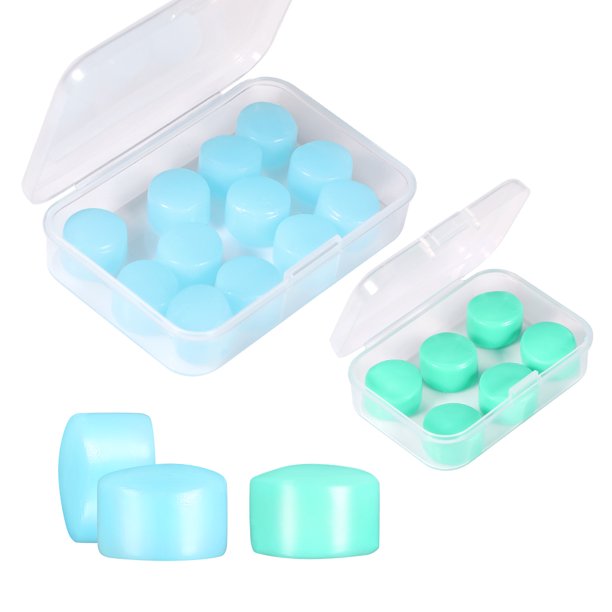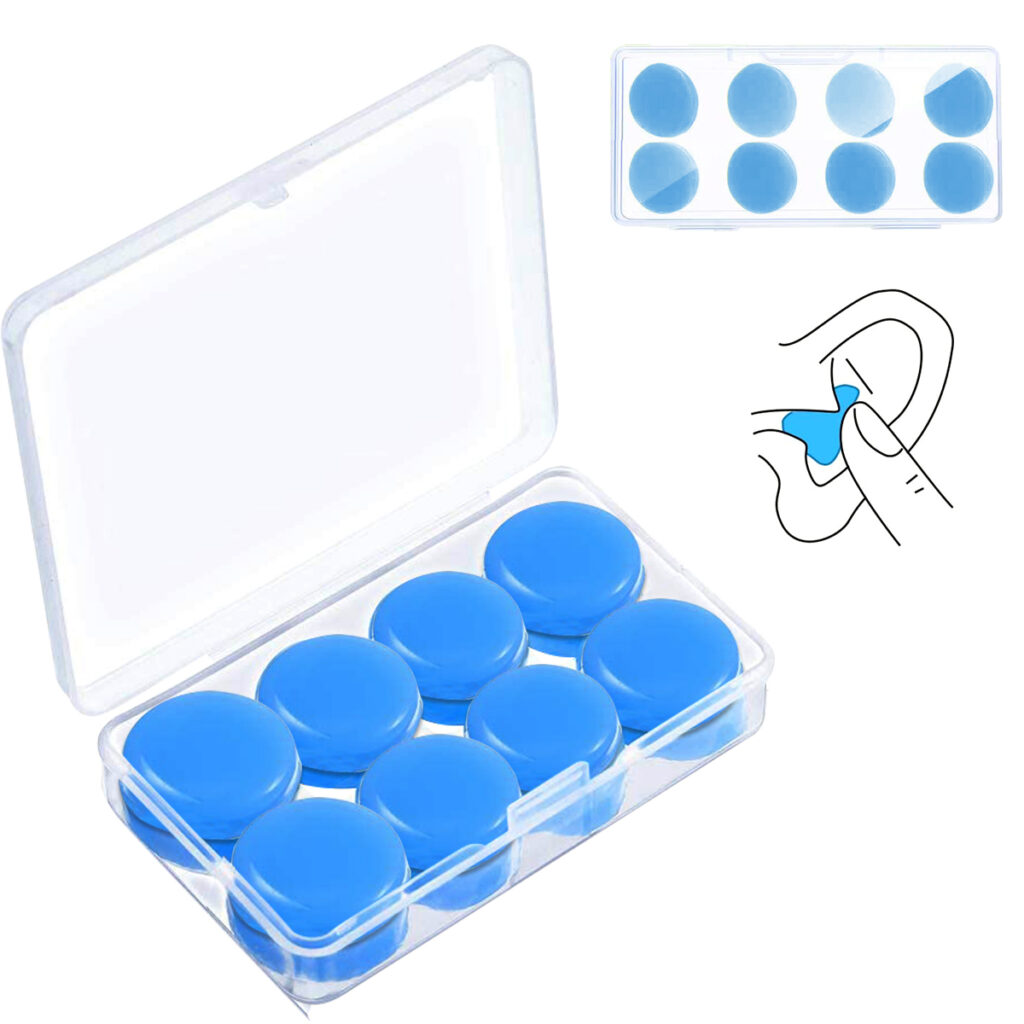Are you tired of tossing and turning at night, unable to catch a wink of sleep due to your partner’s heroic snores or outside noises? Or perhaps you’re simply keen to protect your ears from the clamorous symphony of life as you navigate through daily commutes and other noisy surroundings? Whatever the reason, using the right earplugs to block out those ever-invasive sounds can mean the difference between a peaceful slumber or daily ease and counting infinite sheep. When it comes to earplugs, the two most popular contenders in the ring for this auditory battle are wax and foam variants. Just like any good duel, there can only be one winner. So, read on as we delve into the debate between wax earplugs and foam earplugs, dissect their respective strengths and weaknesses, and help you decide the ultimate champion of a soundless sanctuary!
Foam, Wax, and Silicone Earplugs: A Comparison
When it comes to selecting the right earplug for your needs, understanding the differences between foam, wax, and silicone options is essential. Foam earplugs are the most popular type, typically made of memory foam that conforms to the shape of your ear canal for maximum noise-blocking properties. Despite their noise-cancellation benefits, foam earplugs may cause discomfort over time as they can exert pressure and cause irritation when inserted into the ear canal.
Wax earplugs, often made from natural beeswax, offer a moldable and comfortable fit. Unlike foam options, they only cover the ear canal entrance, making them more comfortable for extended periods of wear. However, the Noise Reduction Rating (NRR) for wax earplugs usually ranges from 20-23 dB, which may not effectively block out louder noises or snoring.
Silicone earplugs come in two varieties: hard and soft, moldable forms. These types of earplugs are reusable and washable, making them more cost-effective. Like wax earplugs, silicone options provide moderate noise reduction and cover only the ear canal entrance for added comfort. However, they may not be as effective as foam options in extremely noisy environments.
In conclusion, choosing the right earplug depends on the noise levels you need to block and your personal comfort preferences.Foam earplugs provide the best noise reduction while wax and silicone options are more comfortable alternatives for moderate noise situations.
Properties of Foam Earplugs for Sleeping

Foam earplugs are the most popular and widely used type of earplugs for sleeping, mainly due to their affordability and effective noise-blocking capabilities. Made from memory foam, these earplugs conform to the shape of the wearer’s ear canal for an optimal seal, blocking out a significant amount of noise. With Noise Reduction Ratings (NRR) ranging between 28-33 dB, foam earplugs can efficiently block out loud noises such as construction work or snoring.
However, they have some drawbacks that may affect users who experience discomfort while wearing them. Since foam earplugs need to be inserted deep into the ear canal to provide maximum noise reduction, some individuals may experience ear pressure, itching, or irritation, which can become uncomfortable after several hours of use. Additionally, foam is a porous material, making it more susceptible to harboring bacteria. As a result, it is essential to replace foam earplugs frequently to avoid the risk of ear infections.
In conclusion, foam earplugs are an excellent choice for individuals in search of an affordable and efficient solution to block out noise while sleeping. However, for those who find foam earplugs uncomfortable or irritating, they may want to explore alternatives such as wax or silicone earplugs for a more comfortable sleeping experience.
Benefits of Foam Ear Plugs
When it comes to protecting your hearing in loud noise environments, there are a variety of ear plug options to choose from, including wax ear plugs, silicone ear plugs, and foam ear plugs. However, many individuals may prefer foam ear plugs because they have several advantages over their counterparts. For one, foam ear plugs are relatively inexpensive, making them a cost-effective choice for those on a budget. Additionally, they are easy to use and can be disposed of after each use, meaning you don’t have to worry about cleaning and reusing them. While wax and silicone ear plugs may offer benefits of their own, foam ear plugs are a great choice for individuals looking for a simple and convenient hearing protection solution.
When it comes to choosing the right ear plugs to protect your hearing, there are a lot of options to choose from. While wax and silicone ear plugs have their benefits, foam ear plugs are widely regarded as the superior option for sound dampening. This is because they form a tight seal within the ear canal, effectively blocking out more sound than their counterparts. Wax and silicone ear plugs tend to fit more loosely in the ear, which can allow sound to seep through. Additionally, foam ear plugs are often more comfortable to wear for extended periods of time, as they conform to the shape of the ear canal. While wax and silicone ear plugs may be more convenient options for occasional use, if you’re seeking maximum protection from noise pollution or loud environments, foam ear plugs are definitely worth considering.
Additionally, when comparing wax ear plugs, silicone ear plugs, and foam ear plugs, it becomes clear that foam ear plugs are the most versatile option. While wax ear plugs may provide a customized fit, they are not reusable and may be uncomfortable for long-term wear. Silicone ear plugs, on the other hand, may be comfortable but may not offer the same level of protection against noise. Foam ear plugs, however, strike the perfect balance between comfort and protection. They are designed to fit comfortably in the user’s ear while still providing reliable protection from damaging levels of noise as they expand to form a perfect seal. Overall, when it comes to choosing between wax ear plugs, silicone ear plugs, and foam ear plugs, foam ear plugs are the clear winner.
Pros and cons of Foam Earplugs
Foam earplugs are a popular choice for many people due to their affordability and effectiveness in blocking out noise. They are made of memory foam, which allows them to conform to the shape of the user’s ear canal, providing an excellent noise-blocking seal. With a high NRR (noise reduction rating) of up to 33 dB, foam earplugs are ideal for those living in noisy environments or seeking maximum noise reduction when sleeping.
However, there are some downsides to using foam earplugs. Their non-moldable nature can cause pressure in the ear after prolonged use, which may lead to discomfort. This could be particularly bothersome for individuals with sensitive ears or those who find it irritating to have earplugs inserted into their ear canal. Moreover, foam earplugs can cause itching and irritation due to their porous material, which can harbor bacteria. This necessitates frequent replacement of the earplugs to avoid potential ear infections.
In summary, foam earplugs offer excellent noise reduction at an affordable price but may not provide the highest level of comfort for some users. Their porous material also requires attentive maintenance to ensure cleanliness and avoid infection. While these drawbacks should be taken into account, foam earplugs remain a popular choice for those seeking a budget-friendly noise-blocking solution.
Properties of Wax Earplugs for Sleeping

Wax earplugs, made predominantly from natural wax, have several unique properties that make them an ideal choice for sleeping. Firstly, they are highly moldable, allowing users to easily adjust the shape of the earplug to fit their ear perfectly. This not only ensures a secure fit but also provides maximum comfort throughout the night.
As opposed to foam earplugs which need to be inserted deeply into the ear canal, wax earplugs only cover the ear canal entrance. This feature makes them far more comfortable and less intrusive for individuals who might find foam earplugs irritating or uncomfortable. Furthermore, wax earplugs are composed of non-porous and non-absorbent materials, reducing the chances of bacterial growth and minimizing the risk of ear infections.
Although wax earplugs have a slightly lower noise reduction rating (NRR) compared to foam earplugs, they generally perform well in moderately noisy environments. With an NRR ranging from 20-23 dB, they can effectively block out ambient noise while still allowing the user to maintain a degree of situational awareness.
In conclusion, wax earplugs are an excellent choice for those seeking a comfortable, moldable, and non-intrusive earplug for sleeping. While they may not provide the same level of noise reduction as foam earplugs, their unique properties make them suitable for individuals with sensitive ears or those who prioritize comfort and ease of use.
Benefits of Wax Ear Plugs
When it comes to ear plugs, there are a variety of options on the market to choose from, each with their own unique benefits. However, for those seeking ultimate comfort and a personalized fit, wax ear plugs are the superior choice. Unlike silicone or foam ear plugs, wax ear plugs offer unmatched malleability that allows them to be molded to the exact shape of the wearer’s ear. This results in a perfect fit that not only creates a barrier against noise and water, but also ensures comfort during long-term use. Additionally, wax ear plugs are an excellent option for individuals with sensitive skin or allergies, as they do not contain any harsh chemicals or synthetic materials. Furthermore, they can be easily removed with a gentle twist or pull, making them a convenient and hassle-free choice for everyday use. Overall, wax ear plugs are the perfect solution for anyone looking for a comfortable, customizable, and effective method of protecting their ears.
Thus, when it comes to choosing the right ear plugs for protecting your ears in loud environments, wax ear plugs, silicone ear plugs, and foam ear plugs are all viable options. However, it seems that foam ear plugs are the most commonly used as they are comfortable, affordable, and easy to find. On the other hand, if you prefer something reusable, both wax and silicone ear plugs are great choices. Additionally, both wax and silicone ear plugs can provide excellent noise-cancellation capabilities, making them perfect for use in loud environments like concerts or construction sites. Ultimately, the choice comes down to personal preference and the specific needs of the situation, but whatever type of ear plugs you choose, make sure to prioritize your hearing health by using them effectively and consistently.
Pros and cons of Wax Earplugs
Wax earplugs have been a popular choice for many individuals for years, owing to their unique properties and advantages over other types of earplugs. However, they also come with certain drawbacks that may make them unsuitable for some users. In this article, we will discuss the various pros and cons of wax earplugs.
Pros of Wax Earplugs:
1. Customizable fit: One of the biggest advantages of wax earplugs is their moldable nature. They can be easily shaped to fit the unique contours of each person’s ear canal, ensuring maximum effectiveness in blocking out unwanted noise.
2. Comfort: Wax earplugs are considered to be quite comfortable, as they only cover the entrance of the ear canal without entering it. This eliminates pressure on the sensitive inner-ear tissue, reducing the risk of irritation and discomfort.
3. Increased situational awareness: Unlike foam earplugs, wax earplugs do not block out all noise, allowing users to maintain some level of situational awareness, which can be beneficial in certain environments.
4. Natural material: Wax earplugs are usually made from natural materials, such as beeswax, which may be preferable to some individuals who prefer eco-friendly options.
Cons of Wax Earplugs:
1. Lower Noise Reduction Rating (NRR): Wax earplugs generally have a lower NRR compared to foam earplugs, meaning they may not be as effective in blocking out extremely loud noises or snoring.
2. Less durable: Wax earplugs tend to be less durable than silicone or foam alternatives, meaning they may need to be replaced more often, leading to higher long-term costs for regular users.
3. Not suitable for all environments: Wax earplugs may not be the ideal choice in high moisture environments, such as swimming or high-intensity workouts, as they may lose their shape and effectiveness over time.
4. Hygiene concerns: As wax is a natural material, it can harbor bacteria, necessitating frequent replacement to avoid potential ear infections.
Properties of Silicone Earplugs for Sleeping:

When it comes to sleep, many individuals are particular about their choice of earplugs, and silicone earplugs have gained popularity as one of the preferred options. Silicone earplugs come in two varieties: moldable soft silicone and hard silicone earplugs. Their significant advantage over foam and wax earplugs is their reusability, as long as they are kept clean, which makes them a cost-effective choice for regular use.
Moldable silicone earplugs share similarities with wax earplugs in terms of comfort, as they are soft and easily conform to the shape of the ear canal entrance. Their noise reduction capabilities, however, are not as strong as foam earplugs. With an average noise reduction rating (NRR) of 22-23 dB, silicone earplugs are most effective in moderate noise environments, providing adequate noise reduction while maintaining situational awareness.
One notable downside of silicone earplugs is their tendency to be less effective in extremely loud environments, as they may not provide sufficient noise blocking compared to foam earplugs. Nevertheless, for individuals who prioritize comfort over maximum noise reduction or who find ear canal insertion irritating, moldable silicone earplugs are an excellent choice for sleep.
In summary, silicone earplugs are a reusable, comfortable, and cost-effective option for sleeping in moderate noise environments. Their versatility and easy-to-clean nature make them a popular alternative to foam and wax earplugs.
Benefits of Silicone Ear Plugs
When it comes to choosing ear plugs, one of the main considerations is the material they’re made of. Silicone ear plugs are often considered the superior option compared to wax or foam ear plugs. This is due to their customizable shape which provides a comfortable and secure fit in the ear. Additionally, silicone ear plugs are able to effectively block out noise due to their ability to create a tight seal in the ear canal. In contrast, wax or foam ear plugs may not fit as well or provide as much noise reduction. All three types of ear plugs have their pros and cons, but for those looking for maximum comfort and noise reduction, silicone ear plugs are often the way to go.
When it comes to ear plugs, there are many options available on the market. Among the most popular types are wax, foam, and silicone ear plugs. While wax and foam ear plugs may be more commonly used due to their affordability and accessibility, silicone ear plugs stand out for several reasons. One of the key advantages of silicone ear plugs is their longer lifespan compared to wax or foam ear plugs. This means they can be reused for a longer period, making them more cost-effective in the long run. Additionally, their flexibility and softness make them easier to insert and remove from the ear. This is especially beneficial for those who need to use ear plugs frequently or for extended periods, as they can avoid any discomfort or irritation that may be caused by harder or stiffer materials. Overall, silicone ear plugs offer a reliable and convenient solution for those looking for effective ear protection.
All in all, when it comes to deciding between wax ear plugs, foam ear plugs, or silicone ear plugs, it is important to consider your individual needs and preferences. While wax ear plugs may provide a comfortable fit for some individuals, they may not be ideal for those with allergies or sensitivity to certain materials. Similarly, foam ear plugs may provide effective noise cancellation but may need to be replaced more frequently due to their disposable nature. Alternatively, silicone ear plugs are a versatile and reusable option that can be washed and used multiple times, making them both cost-effective and eco-friendly. With the convenience of being able to clean them and use them over again, silicone ear plugs give us the opportunity to prioritize health and cleanliness while also enjoying much-needed peace and quiet.
Pros and cons of Silicone Earplugs
Silicone earplugs have become a popular choice for many people seeking a comfortable and effective noise reduction solution. The main advantages of silicone earplugs lie in their reusability, washability, and adaptability to various noise levels. However, like any other product, silicone earplugs have their drawbacks as well.
One key pro of silicone earplugs is their reusability, making them a cost-effective option compared to disposable foam or wax earplugs. They can be washed and reused multiple times, providing a more eco-friendly alternative. Furthermore, they are often made from soft, moldable materials that can be easily adjusted for a comfortable fit, catering to the needs of individuals with sensitive ears or those who prefer not to insert earplugs deep into the ear canal.
Despite their benefits, silicone earplugs may not provide the same level of noise reduction as foam earplugs. Their noise reduction ratings (NRR) typically range from 20 to 28 dB, which may not be sufficient for extremely loud environments. Additionally, hard silicone earplugs can be less comfortable than their soft, moldable counterparts. Hence, it is essential to choose the right type of silicone earplug for the specific situation and individual preferences.
In summary, silicone earplugs offer a reusable, washable, and comfortable solution for noise reduction, but they may not always provide the same level of noise blocking as foam earplugs. Carefully considering the pros and cons of silicone earplugs will help ensure the right choice for one’s particular needs.
Comfortability of Earplugs and Ear Canal Irritation
It is essential for users to select the right type of earplugs to avoid discomfort and prevent ear canal irritation. Foam, wax, and silicone earplugs each have their own merits in terms of comfortability and suitability for different users.
Foam earplugs are popular for their effective noise-blocking properties, but they may not be ideal for users with sensitive ears. Due to their insertion into the ear canal, foam earplugs can cause pressure, itching, and irritation after prolonged use. Moreover, foam is a porous material that can harbor bacteria, making it essential to replace these earplugs frequently to avoid infections.
On the other hand, wax earplugs are considered more comfortable as they cover the ear canal instead of entering it. They are made from moldable natural wax, often beeswax, providing an easy and comfortable fit. However, their noise reduction rating (NRR) is lower compared to foam earplugs, making them a better option for moderate noise environments.
Silicone earplugs are available in both hard and moldable varieties, with the latter being more comfortable, similar to wax earplugs. One of their biggest advantages is their reusability, provided they are kept clean. Silicone earplugs work well in moderate noise environments, offering users a comfortable, reusable, and effective noise reduction solution.
In conclusion, when choosing earplugs, it is crucial to consider individual comfort and sensitivities to avoid irritation and enhance the overall experience.
Importance of Earplugs in Sleep Quality Improvement
Achieving good quality sleep is crucial for maintaining physical and mental health, as it allows our bodies to rejuvenate and our minds to rest. However, various factors can disrupt sleep, including exposure to noise pollution from traffic, snoring partners, or noisy neighbors. One effective solution to minimize these disturbances and improve sleep quality is the use of earplugs.
Scientific research has shown that using earplugs can significantly enhance the sleep experience, as they effectively block or reduce external noise, promoting a peaceful, sleep-friendly environment. This uninterrupted sleep is essential for our bodies to indulge in the restorative process of deep sleep, supporting cognitive function, and overall well-being.
However, ensuring the right choice of earplugs is vital for comfort and effectiveness. There are three main types of earplugs available: foam, wax, and silicone, each with its specific benefits and drawbacks. Foam earplugs are the most popular because they are soft, comfortable, and provide excellent noise reduction. Wax and silicone earplugs are moldable, easily conforming to the ear’s shape for a snug fit, and are suitable for users who may be sensitive to pressure inside their ear canal. Ultimately, finding the right type of earplugs could be the key to unlocking the benefits of quality sleep and leading a healthier life.
How to Choose the Right Type of Ear Plugs for Your Needs
When it comes to selecting the perfect pair of ear plugs, one must carefully consider the different characteristics of wax ear plugs, silicone ear plugs, and foam ear plugs. For those who prioritize comfort and effective noise reduction, wax ear plugs are a perfect choice. Meanwhile, silicone ear plugs are ideal for those seeking a more secure fit and the ability to reshape and reuse repeatedly. However, if cost-effectiveness is your biggest concern, foam ear plugs may be the way to go, although they may not offer the same level of sound dampening. Ultimately, the decision between wax ear plugs vs silicone ear plugs vs foam ear plugs depends on personal preferences and the specific needs of the wearer.
When it comes to choosing the right ear plugs, there are a few options available that individuals can consider, namely wax, silicone, and foam ear plugs. Wax ear plugs are a popular choice because they provide good sound dampening capabilities and offer a comfortable fit. However, they need to be replaced often due to their soft texture and can be challenging to insert properly. On the other hand, silicone ear plugs offer similar sound dampening abilities and are more pliable than wax ear plugs. They can be reshaped and reused, making them a more cost-effective option in the long run. Nonetheless, if not inserted correctly, they may cause irritation and discomfort. Lastly, foam ear plugs are an economical option but must be replaced regularly because they are porous and provide less sound dampening than wax or silicone ear plugs. Ultimately, choosing the right ear plugs depends on factors such sound sensitivity, comfort, and durability, and individuals should experiment with different types to find which works best for them.
Meanwhile, the decision between wax ear plugs, silicone ear plugs, or foam ear plugs ultimately comes down to personal preference and specific needs. While foam may be a more economical solution, the comfort level may not be suitable for some individuals. In contrast, silicone or wax ear plugs may provide better comfort and customization for different ear sizes and shapes. It is important to consider the level of noise reduction needed and how the ear plugs will be used. Whether it is for sleeping, swimming, or attending music concerts, the right choice can make all the difference. In conclusion, by carefully assessing the pros and cons of each type of earplug, one can make a more informed decision and choose the best fitting solution for their needs.
To Conclude
In conclusion, choosing the right type of ear plugs for your needs comes down to personal preference and the specific situation in which you’ll be using them. Foam earplugs are the most affordable and versatile, making them a great option for general use. Silicone earplugs offer a comfortable fit and are ideal for those with sensitive ears or who need to wear earplugs for extended periods. Wax earplugs provide the most effective noise reduction but can be a bit trickier to fit correctly. Ultimately, it’s important to consider factors such as comfort, effectiveness, and price when choosing the right type of earplugs for your needs. With a little research and experimentation, you’re sure to find the perfect pair of earplugs to help you enjoy some much-needed peace and quiet.




